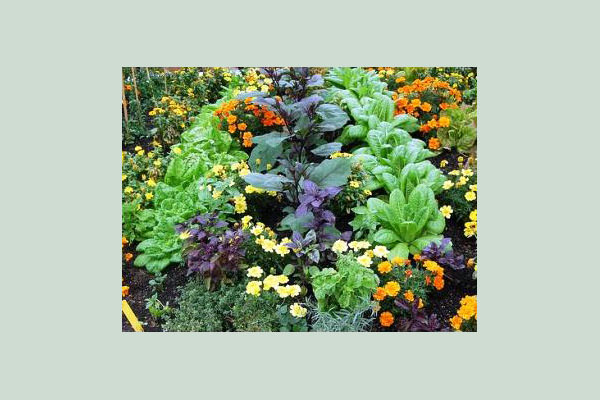






Interplanting just means growing several different plants amongst each other. There are many benefits to growing herbs and flowers throughout your vegetable crops – one is that they look great, combining beauty and purpose.
The original cottage garden style is believed to have evolved from the interplanting of herbs and flowers amongst the vegetables. So what benefits are there to growing plants together in the veggie garden?
1. Confuse Garden Pests by interplanting a variety of plants together. This masks the smell and shapes of plants which pests use to locate their favourite foods. For example: if you plant carrots and onions together it confuses both the onion fly and carrot fly! Generally speaking, the greater variety of herbs and flowers you have growing in your vegetable garden, the fewer insect problems you’ll have.
2. Encourage Beneficial Insects by planting flowers and herbs that they love to live near. Garlic chives, dill, fennel, garlic chives, parsley, shasta daisies, yarrow and flowers of the aster family are favourites of many beneficial insect, including parasitic wasps, ladybird beetles and lacewings.
The adult insects feed on flower nectar and pollen, then lay eggs on garden crops. When the eggs hatch, the ravenous larvae of these beneficial insects devour the pests that may plague your crops. This way the pest and beneficial insects balance themselves out – just as nature intended.
3. Attract Pollinators to your garden with nectar and pollen rich flowers or flowers in shades of blue, yellow or white. This will attract bees and other pollinators, making sure you get good fruit set in crops such as tomatoes, eggplant, peppers and cucurbits.
4. Reduce Weeds by interplanting as thickly as possible. This is particularly useful for gardeners with little space. Planting thickly provides a living mulch, allowing little opportunity for weeds to take over.
Formal gardens with many sections for specific types of plants was once a great indulgence of the rich. Some people still seem to like the mono-culture look, but I prefer my garden a little on the wild side. And my garden rewards me with an ongoing supply of fresh vegetables, herbs and flowers – all living happily together.
Nature doesn’t create a line in the earth and have one species grow on one side, with another species growing on the other. Diversity is one of the great splendours of nature. Can you imagine a rain forest with just two or three species growing there? By interplanting and using Companion Planting techniques we can emulate nature and encourage eco-systems and bio-diversity in our own back yards.
Happy gardening, healthy living…
Article By Julie Williams. http://www.1stoporganicgardening.com
Reasons to Fall in Love with Your Pop Up Greenhouse
How to Take Great Photos of Your Vegetable Garden
How to Make Money with your Vegetable Garden
Key Points To Success With Your Organic Vegetable Garden
Discovering Your Inner Green Thumb With an Indoor Vegetable Garden
Start Your Garden Today With the Basics of Vegetable Gardening
Achieving Your Health Interest With Home Vegetable Garden Design
Dealing With Pests In Your Vegetable Garden
Growing Some Vegetable In Your Garden
How To Decorate Your Garden With Blue Flowers
Learn and Create: Building an Herb Garden with Your Kids
How To Start A Vegetable Garden - 30 Day Challenge - The Great Pollinators
Coming Up With a Great Garden Design
Coming Up With a Great Vegetable Garden Design Idea: Use the Internet
Copyright © www.100flowers.win Botanic Garden All Rights Reserved